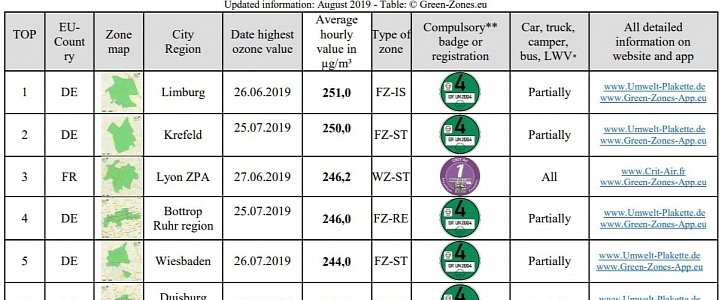For more than a decade, countries in the European Union have been following EU regulations against pollution caused by particulate matter and nitrogen dioxide. The EU Air Quality Directive from 2008 works in direct relation with the EU environmental zones.
Environmental Zones are areas where concentrations of mostly man-made volatile gas ozone top a certain limit. At ozone concentrations of 200 µg/m³, man begins to experience health issues, including premature aging of the lungs, headaches, irritation of the throat and of the eyes, and chest discomfort. Authorities alert the population whenever the concentration nears 180 µg/m³ and can – and should – instate driving bans.
Higher ozone concentrations occur during the hot summer months, when man-made volatile organic compounds (VOC) and nitrogen oxides (NOx) react with UV radiation: that’s when “smog” or haze appears. In the summer of 2019, the most dangerous environmental zones were in Germany and the Netherlands, and just one in France, portal Green-Zones has determined. Only partial driving bans were instated in some of the zones, despite the very high levels of the potentially carcinogenic toxic gas.
“The German city of Darmstadt and the three Dutch cities of Arnhem, Delft and Rijswijk rank among the last European environmental zones with the highest ozone values (hourly average in micrograms/m³). In these cities it was allowed to drive unhindered with ozone levels of 223-230 µg/m³,” the portal notes in a press release.
Despite EU recommendations, only a few countries have strict regulations on banning driving when high ozone concentrations are reached. However, in most EU countries, you can’t drive a car without an environmental badge or sticker. A few cities have permanent restrictions on diesel vehicles.
“The environmental zones of the German Ruhr area and Wiesbaden are ranked in the middle, where ozone levels of 244-246 µg/m³ were reached in the summer of 2019, without the public being informed significantly. The German city of Limburg ranks 1st among the most dangerous environmental zones in Europe. On 26.06.2019, the European maximum ozone value of 251 µg/m³ was reached as a 1h average value in environmental zones and, unlike the French city of Lyon, no driving ban was imposed,” the portal continues.
Stratospheric ozone occurs naturally in the higher atmosphere. Tropospheric ozone, or ground-level ozone, can also occur naturally but, with increased traffic and heavy industry, these days, it’s mostly man-made. Important sources of volatile organic compounds are cars, power plants, and industrial furnaces and boilers.
Higher ozone concentrations occur during the hot summer months, when man-made volatile organic compounds (VOC) and nitrogen oxides (NOx) react with UV radiation: that’s when “smog” or haze appears. In the summer of 2019, the most dangerous environmental zones were in Germany and the Netherlands, and just one in France, portal Green-Zones has determined. Only partial driving bans were instated in some of the zones, despite the very high levels of the potentially carcinogenic toxic gas.
“The German city of Darmstadt and the three Dutch cities of Arnhem, Delft and Rijswijk rank among the last European environmental zones with the highest ozone values (hourly average in micrograms/m³). In these cities it was allowed to drive unhindered with ozone levels of 223-230 µg/m³,” the portal notes in a press release.
Despite EU recommendations, only a few countries have strict regulations on banning driving when high ozone concentrations are reached. However, in most EU countries, you can’t drive a car without an environmental badge or sticker. A few cities have permanent restrictions on diesel vehicles.
“The environmental zones of the German Ruhr area and Wiesbaden are ranked in the middle, where ozone levels of 244-246 µg/m³ were reached in the summer of 2019, without the public being informed significantly. The German city of Limburg ranks 1st among the most dangerous environmental zones in Europe. On 26.06.2019, the European maximum ozone value of 251 µg/m³ was reached as a 1h average value in environmental zones and, unlike the French city of Lyon, no driving ban was imposed,” the portal continues.
Stratospheric ozone occurs naturally in the higher atmosphere. Tropospheric ozone, or ground-level ozone, can also occur naturally but, with increased traffic and heavy industry, these days, it’s mostly man-made. Important sources of volatile organic compounds are cars, power plants, and industrial furnaces and boilers.












